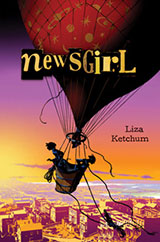
|
Newsgirl
About the Book Amelia’s family has arrived in San Francisco in 1851, hoping for a new life in this gold rush town. But they are nearly penniless. How will they survive? Amelia discovers that newsboys can make a fortune selling east coast newspapers. So in spite of their warning—“No girls in our gang!”—she cuts her hair and dresses herself as a boy. At first, Amelia’s disguise gives her an exciting new freedom. She can hawk newspapers, explore the city, even dream of writing her own news stories. Then an unexpected and harrowing balloon flight drops Amelia in the gold fields. Suddenly facing more adventure than she ever imagined, Amelia resolves that if she makes it back to her family, she’ll find a way to make a living as a newsgirl. Weaving in details of authentic 19th century California, Liza Ketchum has written a fascinating story of San Francisco at the height of its rough and tumble days. Awards and Distinctions Vermont’s Dorothy Canfield Fisher list, 2010 Reviews
“Liza Ketchum has written a rip-roaring piece of historical fiction that will captivate all readers. Amelia’s intrepid nature and the vast chaos of San Francisco in the 1850s are fascinating... The action is non-stop, and readers will delight in Amelia’s adventures, whether they be up in the sky, down in the streets, or along the journey. Hands down my favorite read so far this year.” (Stacy Dillon’s Tweendom blog) “1851 California. Twelve-year-old Amelia, her mother, and her mother’s friend Estelle have journeyed to San Francisco in search of fortune and a place where women can be independent, own property, and fashion a new life together. For Amelia, however, it is the disheartening discovery that if she is to become a newsgirl she must first pretend to be a newsboy! This well-researched historical novel offers an insightful view of gender roles and alternative families in the context of Gold Rush America.” (Michael Cart, ALA Rainbow Book, GLBTQ Books for Children and Teens) “A spirited, smartly paced feminist take on the Gold Rush era.” (Booklist) Behind the Book FAQ: What inspired you to write this story? I first learned about gold rush children in the mid-90s, when I was researching my non-fiction book, The Gold Rush. Two details from that research stayed with me. I was amazed to learn that newsboys could earn more money selling papers on the streets than their parents might make in a day’s work running a store or panning for gold. And I discovered an account of an accidental balloon launch from that time, when a teenage boy went up in a balloon by mistake. He was the first person to see the San Francisco Bay from the air. I filed these stories away in my “Idea File,” hoping that I could weave them into a novel someday. In the early years of the California gold rush, children worked hard to help their families survive. Boys and girls hauled water and cared for animals; they helped their parents run restaurants and shops; and some of the stronger children panned for gold. Boys and girls earned money dancing and singing for the miners in saloons and gambling halls. When the saloons closed for the night, young girls ran their hairpins between cracks in the floorboards to pick up spilled gold dust. My love of newspapers also inspired me as I wrote this novel. As a little girl, I learned to read by poring over “Little Lulu” comics in the funny pages. Newspapers are in my blood; my great-grandfather wrote stories for western newspapers, and my novel, Orphan Journey Home, has appeared in serial form in newspapers around the country. I love hearing the thump of the paper when it hits the front door early in the morning. During baseball season, I grab the sports section first, to read about my beloved Red Sox. Then I turn to the comics, then the opinion page, and finally, I read the news itself. Like Amelia, I am something of a news hound. FAQ: How much of your story is true? How much is invented? While Amelia and her family are fictional characters, the story’s setting and many events are based on facts. When I write about the past, I imagine that I am taking my readers for a ride in a time machine. As they step out onto San Francisco’s streets in 1851, I want them to smell the city’s gritty smells, to feel the bustle of activity, hear the sounds, and taste the food. I want my story to help a time traveler experience the touch of the wind, the swirling dust, and the cold fog. And I hope my readers will see the city’s landscape and its buildings as they walk in the shoes of the people who came from all over the world in search of gold. I have based San Francisco’s layout—with its shops, wharves, and meeting places—on the maps, directories, newspaper stories, and first person accounts from that period. The stories that Amelia sells to the papers are invented, but the Alta California was a real paper, as was the Sonora Herald, the first newspaper in the southern mines. Dr. Gunn, who appears in the novel, was a real person and the editor of the Herald. The Boston headlines that Amelia calls out are actual headlines from Eastern papers of that time. In 1848, San Francisco was a sleepy hamlet. After the gold discovery, it exploded into a city, as thousands of travelers arrived to seek their fortunes. Many went to the mountains to pan for gold, while others decided to stay in the city. They lived in hastily built shacks, tents, abandoned ships, and “iron houses.” The city burned—and was rebuilt—so many times that residents named it “Phoenix City,” like the mythical bird that rises from the ashes. The fire that Amelia survived took place on May 4, 1851; exactly one year to the day after a similar fire destroyed the city. While the Alta California was the only newspaper to escape the flames of the May 1851 fire, it did succumb to a second disastrous fire in June of that year. But the city’s residents wouldn’t give up. First-person accounts of both fires describe the sounds of men hammering and sawing, rebuilding their homes while the city still smoldered. FAQ: Did people really go up in balloons during that time? From the moment I started to write Amelia’s story, I wanted to include a balloon ascent such as the one I’d read about. But was it true—or even possible? A librarian at the Boston Public Library introduced me to Tom D. Crouch’s wonderful book, The Eagle Aloft: Two Centuries of the Balloon in America. From this book, I learned that ballooning was an active sport in the 19th century. And I found a detailed account of the California teenager’s accidental flight. According to Crouch, an aeronaut in Oakland had tried to launch a balloon filled with hydrogen, but the adults who hoped to be its first passengers were so heavy that the balloon couldn’t take off. Joseph Gates, a sixteen-year-old boy selling oranges, volunteered to try it out. The balloon was tied onto a flimsy board, rather than a basket, but Gates climbed on. Much to his surprise, the balloon lifted and sailed away. According to one newspaper account, when the balloon’s valve line became tangled in the net, Gates “shinned up” and cut the line free with a knife. He landed in a flat area miles from the liftoff and returned to San Francisco by boat. The year was 1852. Apparently, he never went near a balloon again. FAQ: Where do you find the historical details for your books? I do much of my research in libraries and historical societies. I am lucky to live in the Boston area, home to many wonderful research libraries. As I wrote Newsgirl, I searched for letters, diaries, and journals written by people who went out to California during the Gold Rush, and I looked for information about native California Indians and Mexican Californios who lived there before the rush began. I also studied maps and drawings and—of course—I read newspapers from that time period. Old newspapers are usually available on microfilm, which is difficult to read and hard on the eyes. Once in a while, I’m lucky enough to read an original paper from that time. If the paper is old and fragile, I might wear plastic gloves. I have to be careful not to tear the pages as I turn them. I study the news stories so that I know about the daily events that were happening as my story unfolded. Sometimes I can use those events—as I did with the fire—to help with my plot. And I also read the ads. The ads help me understand how people dressed, what foods they ate, where they shopped, and what was for sale in the stores. The ads gave me important information about the city’s restaurants, hotels, and businesses, and about the wharves where ships came in from around the world. When I wrote about Amelia and Patrick’s balloon ride, I wanted to describe that part of California as they saw it from the air—but I couldn’t take a balloon ride myself! Instead, I logged onto Google Earth, and I was able to zoom in on San Francisco and plot a path the balloon might take as the wind blew it to Sonora. I then “flew” that route, using the mouse on my computer to take me from west to east. I could imagine what Amelia and Patrick might have seen as I soared over the hills, valleys, and rivers, flying lower than an airplane, but higher than a bird. Try it yourself! It’s a great ride. |
 |
 |
 |
 |
